Key takeaways:
- Reflections in photography evoke emotions and enhance storytelling by creating layered narratives, as seen in various settings like lakes and urban environments.
- Mirrors are crucial tools for manipulating light and perspective, offering creative possibilities in self-portraiture and still life photography.
- Effective techniques involve experimenting with natural lighting, composition angles, and spontaneity to capture compelling mirror shots.
- Showcasing reflection photography emphasizes emotion and the interplay between man-made and natural elements, inviting viewers to explore deeper narratives.
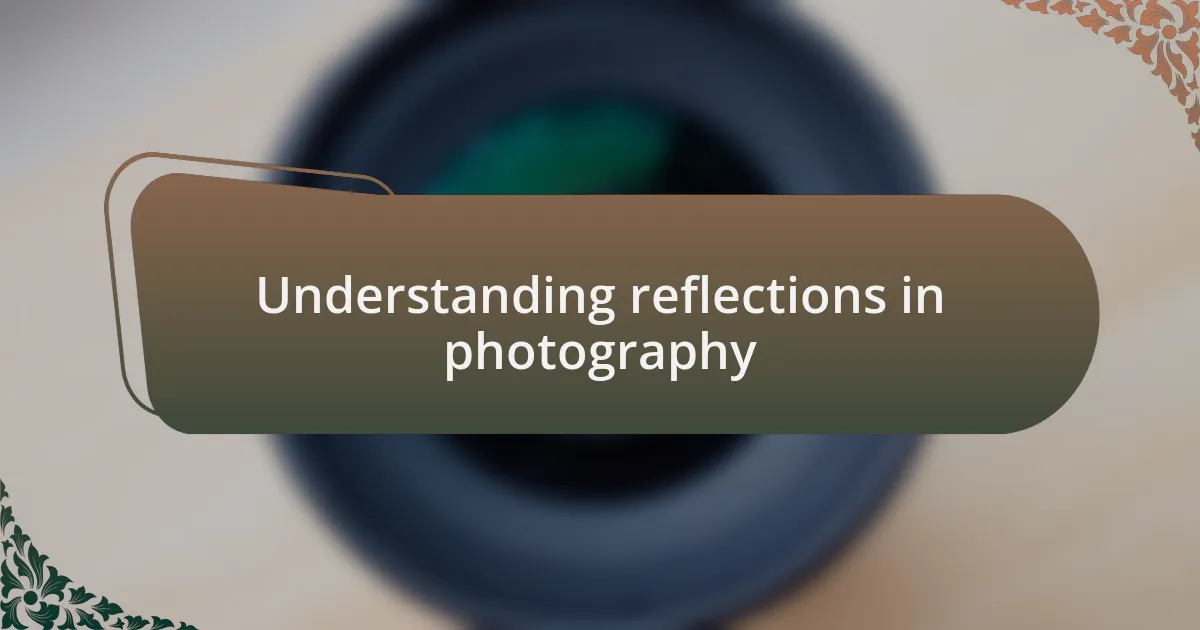
Understanding reflections in photography
Reflections in photography are more than just visual elements; they evoke emotions and tell stories. I remember capturing a serene lake at dusk, where the water mirrored the fiery sky. The symmetry created a feeling of tranquility, emphasizing how reflections can elevate the emotional resonance of an image.
When I think about the role of reflections, I often wonder: How do they shift our perception of reality? For instance, I once photographed a bustling cityscape through a glass building, creating a layered effect that showcased both the urban life and the serene sky. This interplay invites the viewer to consider the complex narratives that lie within such scenes.
Reflections can also serve as powerful compositional tools. In one of my favorite shots, I used a puddle to capture the essence of an old street after rain. The way the colorful buildings shimmered in the water brought depth and intrigue to the photograph, transforming a simple moment into something extraordinary. This experience highlights how reflections can guide the viewer’s eye and enhance the overall storytelling in your photography.
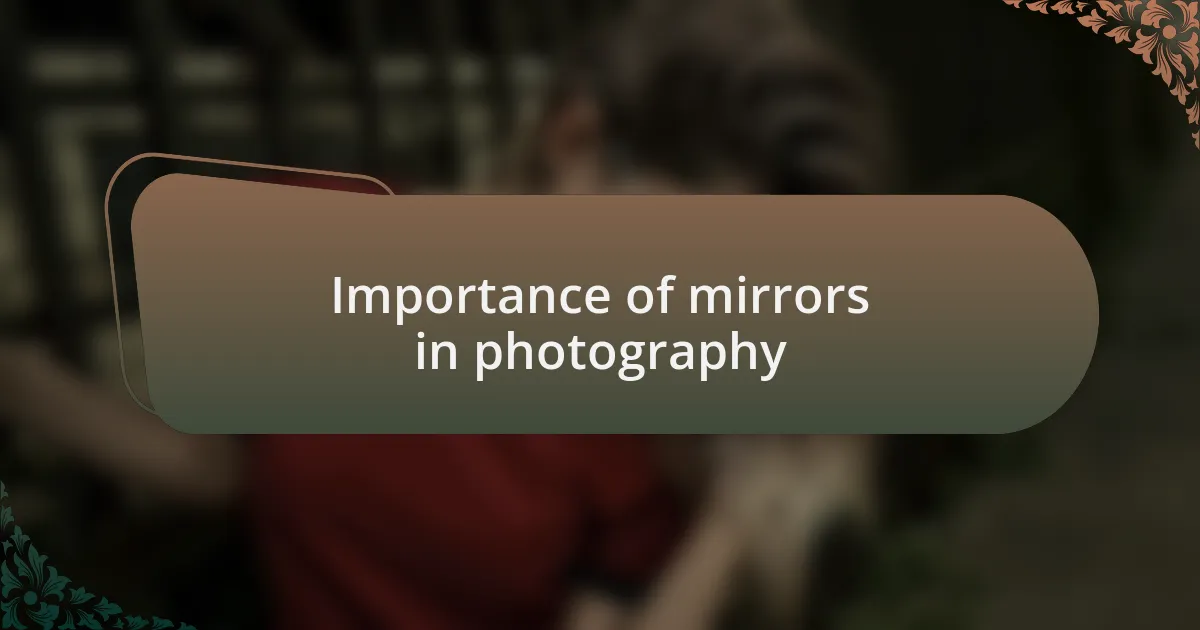
Importance of mirrors in photography
Mirrors play a crucial role in photography, allowing us to manipulate light and perspective in visually captivating ways. I recall a time when I set up a shot using a handheld mirror to reflect the sunset onto my subject. The resulting image not only highlighted the vibrant colors of the sky but also added an unexpected twist that made the composition more dynamic. This technique opened my eyes to the endless creative possibilities mirrors offer.
The functionality of mirrors extends beyond aesthetics; they also enhance technical aspects of our images. When I experimented with a mirror inside my studio, it provided a unique angle that transformed the entire atmosphere of the shot. The subtle reflections added depth and dimension, turning an otherwise flat image into something more engaging. How often do we consider the technical marvels that mirrors can introduce to our compositions?
Incorporating mirrors often invites introspection, as they can act as a metaphor for self-reflection in our work. I remember one particularly powerful session where the mirror reflected both my subject and their surroundings, creating a narrative about identity and place. This layering of images prompted me to ask: How do reflections shape our understanding of ourselves in different environments? It’s this profound connection that makes mirrors an essential tool for storytelling in photography.
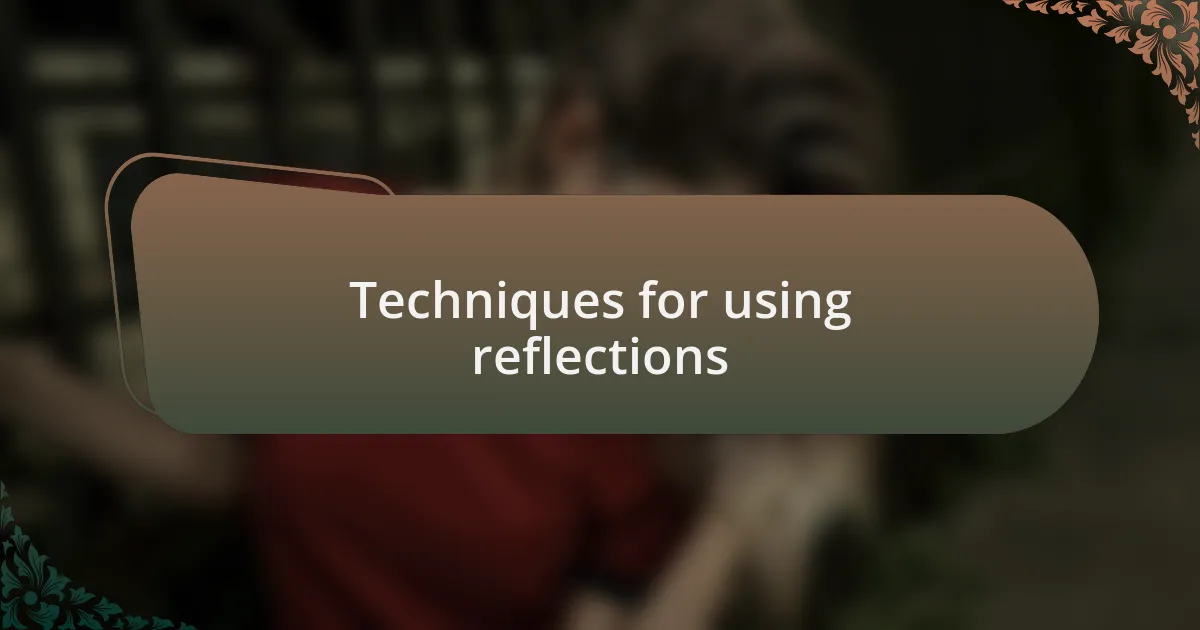
Techniques for using reflections
One of my favorite techniques for using reflections involves finding natural bodies of water, like lakes or ponds. I often scout locations during golden hour, when the light is soft and warm. The challenge lies in positioning my subject just so, allowing their reflection to blend seamlessly with the vibrant hues of the sunset on the water’s surface. There’s a certain thrill in capturing that moment, as it transforms a simple portrait into an ethereal experience.
I also enjoy experimenting with urban environments, where glass buildings can serve as reflective canvases. Once, while wandering through a bustling city, I noticed a striking reflection of an old brick building juxtaposed against a sleek, modern façade. It sparked an idea! By framing my shot to include both elements, I was able to tell a story of contrast and continuity. Have you ever thought about how everyday environments can become powerful backdrops with just a shift in perspective?
Another technique that resonates with me is using multiple mirrors to create intricate patterns and layers. I recall a lively photo shoot with a group of friends where we positioned mirrors at different angles. Not only did it allow us to capture multiple reflections in one frame, but it also turned our session into a playful exploration of identities. Each mirror added a unique twist to the compositions, offering a visual narrative that brought joy and creativity into our work. How can mirrors challenge our perceptions of reality in photography?

Creative ways to include mirrors
Mirrors can serve as a fantastic tool for self-portraiture, adding a layer of intimacy to your photographs. I once set up a vintage hand mirror in a serene garden, capturing my reflection amidst blooming flowers. The juxtaposition of the delicate petals against my image created a sense of harmony that truly resonated with my emotions at that moment, inviting viewers to connect not just with the subject but with the overall mood of the scene.
Incorporating mirrors in still life photography can also yield stunning results. I remember an afternoon spent arranging a collection of cherished items on an antique table, using a large floor mirror to reflect them. This setup revealed hidden details and added depth to the composition. Have you ever experimented with layers, allowing viewers to see beyond the obvious? That’s where the magic happens, and it’s a revelation each time.
Another creative idea that excites me is using mirrors in unexpected places, like busy streets or cafes. I recall capturing a vibrant café scene where the mirror reflected both patrons and the colorful decor. It transformed a mundane moment into a dynamic storytelling piece. How can you challenge your own surroundings with such a reflective approach? It’s a delightful way to make the everyday extraordinary.
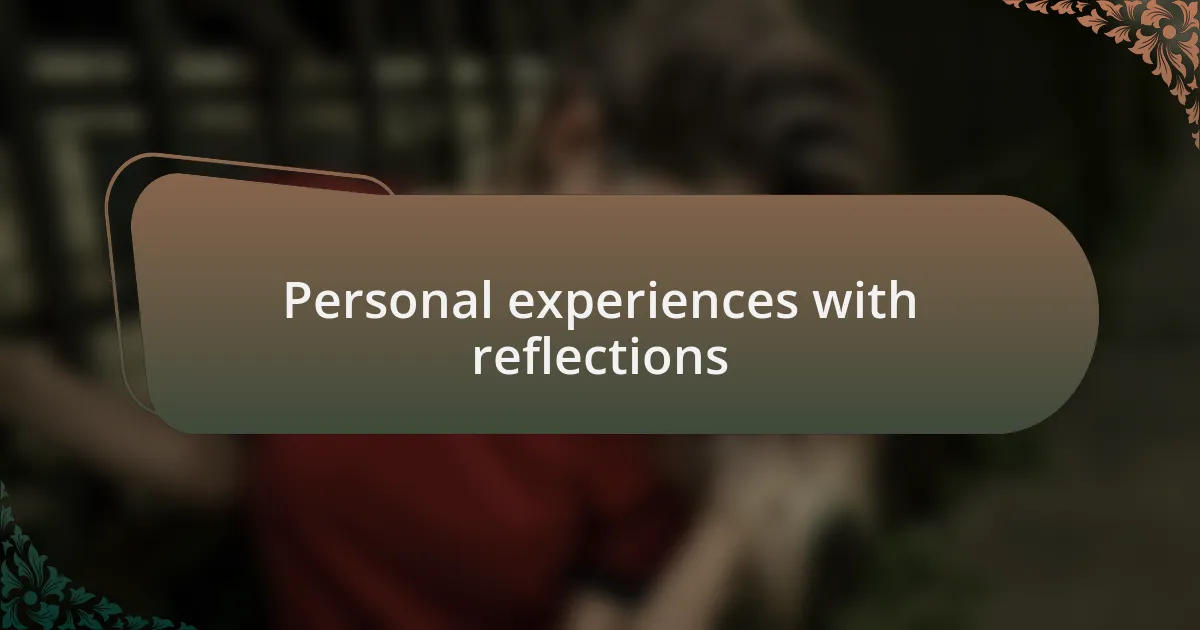
Personal experiences with reflections
There was a day when I ventured to a local lake at sunrise, armed with my camera and an old compact mirror. As the sun kissed the water’s surface, I placed the mirror just so, reflecting the glowing sky into my frame. This simple setup brought an ethereal quality to my photos, making the ordinary feel extraordinary, almost like capturing a fleeting dream.
On another occasion, I visited a historical building filled with ornate mirrors. I decided to try a self-portrait, stepping into the frame of a tall, gilded mirror. It struck me how the reflections captured not only my image but also the stories embedded in the walls around me. In that moment, I pondered: how often do we overlook the narratives hidden within our surroundings? This experience deepened my appreciation for the art of storytelling through reflections.
Most surprisingly for me has been the power of reflections to evoke emotions. I remember snapping a quick shot of friends laughing by a lake, their joyous faces mirrored in the water beside them. Seeing their happiness doubled in the reflection made me realize how reflections can amplify feelings, turning a simple moment into a memorable one. Isn’t it fascinating how something as ordinary as a mirror can transform the way we perceive our environment?
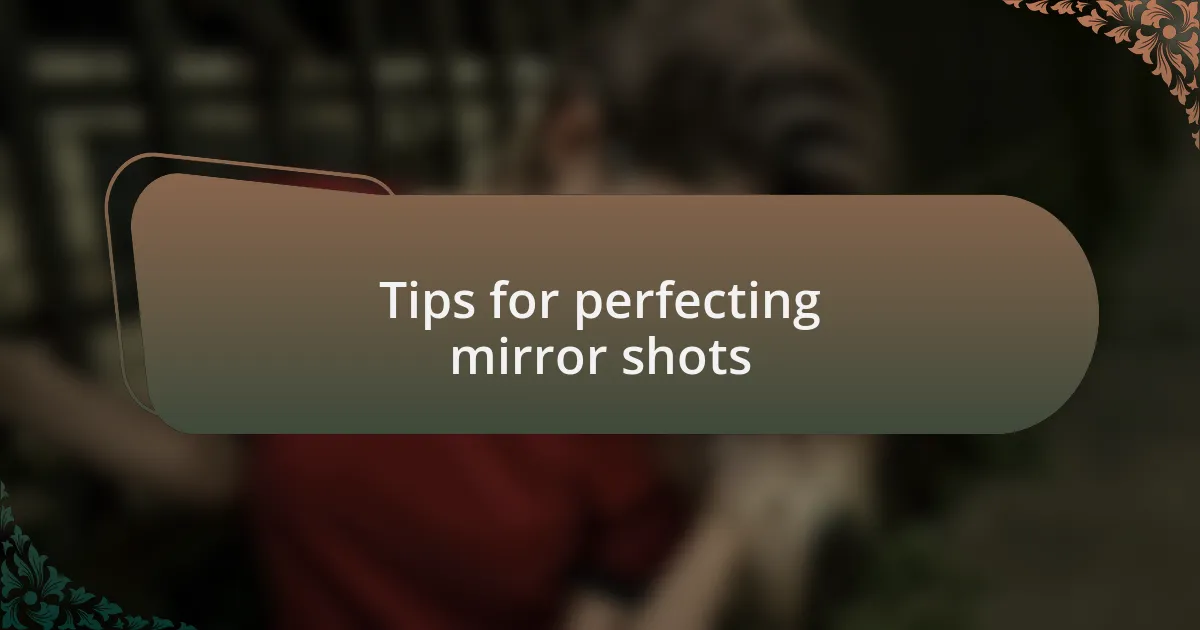
Tips for perfecting mirror shots
To achieve perfect mirror shots, I always emphasize lighting. Natural light can be a game changer, so I often seek out soft, diffused sunlight, especially during the golden hour. Have you ever noticed how a simple change in lighting can transform a photo entirely? For instance, I once took a mirror shot at dusk, and the warm hues that reflected off both the mirror and the surrounding landscape created a stunning interplay of colors.
Composition is another crucial element that I consider. I like to experiment with angles and positions relative to the mirror, often placing the camera at height for a unique perspective. One time, while at a trendy café, I captured a playful selfie using a wall mirror. The off-center composition added an artistic flair, making the image feel more dynamic. This taught me that stepping outside the conventional framing can lead to surprising results.
Finally, I encourage you to embrace spontaneity. Some of my most cherished mirror shots happened when I least expected them. During a recent road trip, I stopped at a vintage shop and spotted a small hand mirror. Without overthinking, I snapped a quick picture of my friend’s reflection and the quirky décor behind her. Sometimes, letting go of structure and allowing creativity to flow can yield remarkable images that are full of life and character. Have you had a moment where you just went for it with your photography? Those often turn out to be the most genuine captures!
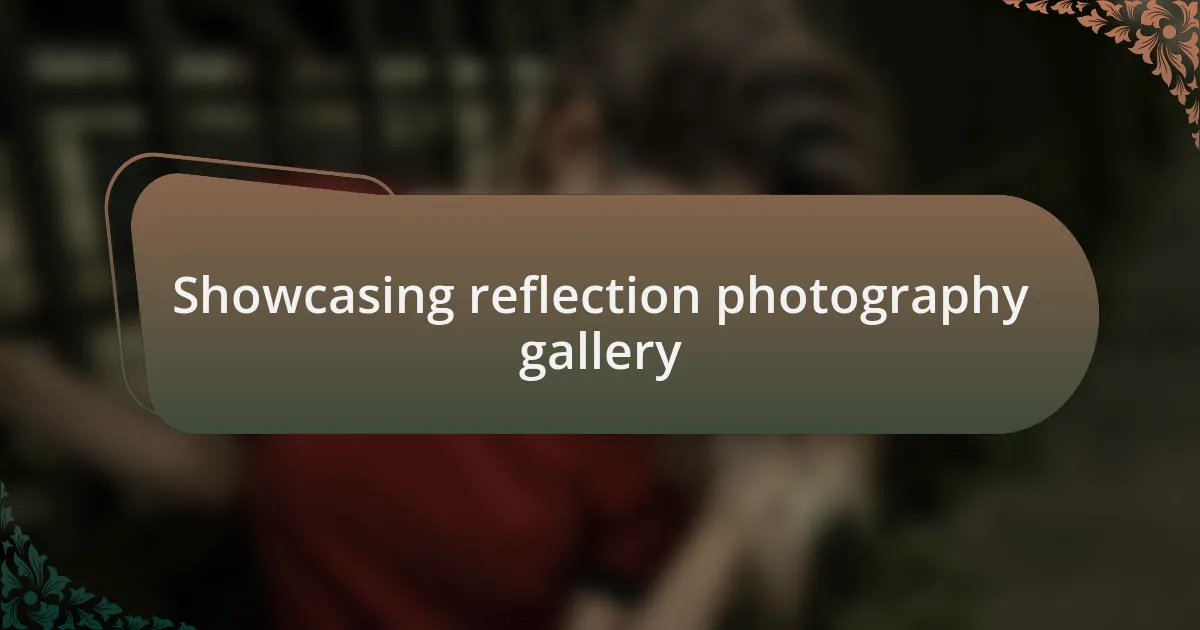
Showcasing reflection photography gallery
Showcasing a reflection photography gallery is a journey through the nuances of light and perspective. I remember curating a collection that centered on waterscapes and urban reflections. Each image told a story—not just of what was visible, but of the layers beneath the surface, inviting viewers to ponder the hidden tales. Have you ever stopped to analyze a reflection and found yourself caught in its depths?
The beauty of reflection photography lies in its ability to evoke emotion. During a trip to a serene lakeside, I captured the mirrored mountains against the calm water. The tranquility of that moment enveloped me, and it struck me that this image could resonate with anyone who craves peace in their busy lives. How can a simple reflection transport us to a different state of mind?
In my gallery, I also highlight the interplay between man-made and natural reflections. I once featured a series of shots that juxtaposed city skylines with the organic forms of nearby trees, each piece sparking thoughts about harmony and chaos. This not only showcased my creativity but also encouraged viewers to contemplate their surroundings. It’s fascinating how reflections can bridge our experiences with the world around us, don’t you think?